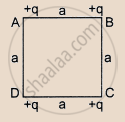Advertisements
Advertisements
प्रश्न
Suppose all the electrons of 100 g water are lumped together to form a negatively-charged particle and all the nuclei are lumped together to form a positively-charged particle. If these two particles are placed 10.0 cm away from each other, find the force of attraction between them. Compare it with your weight.
उत्तर
Molecular mass of water= 18 g
So, number of atoms in 18 g of H2O = Avogadro's number
= 6.023 × 1023
Number of electrons in 1 atom of H2O = (2 × 1) + 8 = 10
Number of electrons in 6.023 × 1023 atoms of H2O = 6.023 × 1024
That is, number of electrons in 18 g of H2O = 6.023 × 1024
So, number of electrons in 100 g of H2O = \[\frac{6 . 023 \times {10}^{24}}{18} \times 100\]
= 3.34 × 1025
Total charge = 3.34 × 1025 × (−1.6 × 10−19)
= − 5.34 × 106 C
So total charge of electrons in 100 gm of water, q1 = −5.34 × 106 C
Similarly, total charge of protons in 100 gm of water, q2 = +5.34 × 106 C
Given, r = 10 cm = 0.1 m
By Coulomb's Law, electrostatic force,
\[= 9 \times {10}^9 \times \frac{5 . 34 \times {10}^6 \times 5 . 34 \times {10}^6}{{10}^{- 2}}\]
\[ = 2 . 56 \times {10}^{25} N\]
This force will be attractive in nature.
Result shows that the electrostatic force is much stronger than the gravitational force between any us and earth( weight = gravitational force between us and earth ).
APPEARS IN
संबंधित प्रश्न
Suppose that the particle is an electron projected with velocity vx = 2.0 × 106 m s−1. If E between the plates separated by 0.5 cm is 9.1 × 102 N/C, where will the electron strike the upper plate? (|e| = 1.6 × 10−19 C, me = 9.1 × 10−31 kg)
One end of a 10 cm long silk thread is fixed to a large vertical surface of a charged non-conducting plate and the other end is fastened to a small ball of mass 10 g and a charge of 4.0× 10-6 C. In equilibrium, the thread makes an angle of 60° with the vertical. Find the surface charge density on the plate.
Find the electric force between two protons separated by a distance of 1 fermi (1 fermi = 10−15 m). The protons in a nucleus remain at a separation of this order.
Two charges 2.0 × 10−6 C and 1.0 × 10−6 C are placed at a separation of 10 cm. Where should a third charge be placed, such that it experiences no net force due to these charges?
Consider a gold nucleus to be a sphere of radius 6.9 fermi in which protons and neutrons are distributed. Find the force of repulsion between two protons situated at largest separation. Why do these protons not fly apart under this repulsion?
Two insulating small spheres are rubbed against each other and placed 1 cm apart. If they attract each other with a force of 0.1 N, how many electrons were transferred from one sphere to the other during rubbing?
Find the ratio of the electrical and gravitational forces between two protons.
Find the speed of the electron in the ground state of a hydrogen atom. The description of ground state is given in the previous problem.
Two identical balls, each with a charge of 2.00 × 10−7 C and a mass of 100 g, are suspended from a common point by two insulating strings, each 50 cm long. The balls are held at a separation 5.0 cm apart and then released. Find.
(a) the electric force on one of the charged balls
(b) the components of the resultant force on it along and perpendicular to the string
(c) the tension in the string
(d) the acceleration of one of the balls. Answers are to be obtained only for the instant just after the release.
Two identical pith balls, each carrying a charge q, are suspended from a common point by two strings of equal length l. Find the mass of each ball if the angle between the strings is 2θ in equilibrium.
A particle A with a charge of 2.0 × 10−6 C is held fixed on a horizontal table. A second charged particle of mass 80 g stays in equilibrium on the table at a distance of 10 cm from the first charge. The coefficient of friction between the table and this second particle is μ = 0.2. Find the range within which the charge of this second particle may lie.
Two particles A and B, each carrying a charge Q, are held fixed with a separation dbetween them. A particle C of mass m and charge q is kept at the middle point of the line AB. Assuming x<<d, show that this force is proportional to x.
A point charge produces an electric field of magnitude 5.0 NC−1 at a distance of 40 cm from it. What is the magnitude of the charge?
Define a unit charge.
Answer the following question.
What is relative permittivity?
Two positive charges ______.
A charge Q is divided into two parts of q and Q – q. If the coulomb repulsion between them when they are separated is to be maximum, the ratio of Q/q should be ______.
Four equal charges q are placed at the four comers A, B, C, D of a square of length a. The magnitude of the force on the charge at B will be ______.

